Robotic navigation and the future of spine surgery
Robotic navigation and the future of spine surgery
In June 2019, under the leadership of Daniel Hedequist, MD, the Spine Division at Boston Children’s Hospital became one of the first pediatric orthopedic centers in the country to use the Mazor X Stealth Edition robotic guidance system in its surgical suite. The system, which received FDA approval in March 2019, combines preoperative planning software, a robotic arm, and stealth navigation to assist surgeons in the placement of surgical hardware as they perform spinal fusion surgery.
Between June 2019 and November 2020, our surgeons in the Spine Division performed more than 75 spinal surgeries using the Mazor X Stealth Edition robotic guidance system. As suspected, introducing the system required an up-front time commitment. Cases took longer in the early stages as surgeons and teams gained experience with robotic navigation. The system was at first used only on straightforward cases involving uncomplicated anatomy and screw placement. After each surgery, clinicians met for a debrief to review the procedures and possible improvements. Today, the Spine Division’s surgical teams use the robotic guidance system broadly to correct idiopathic scoliosis, neuromuscular scoliosis, congenital spine deformities, and spondylolisthesis.
The term “robotic surgeries” suggests that the work of the surgeon is performed by a machine. This assumption does not apply to the Mazor X robotic guidance system. Spine surgeons at Boston Children’s prefer the term “co-botic surgery” in recognition of the surgeon’s very active role throughout the surgery. The surgeon must, for instance, conduct ongoing safety checks to confirm the accuracy of each trajectory suggested by the robotic arm. In the rare case that the robotic arm may be misaligned, the surgeon must catch that potential error before proceeding or risk catastrophic patient injury. According to Hedequist, the Boston Children’s surgeons experience with spinal deformity surgery, and the accuracy of the Mazor X Stealth technology, have allowed for this innovative technology to be safely applied in all cases.
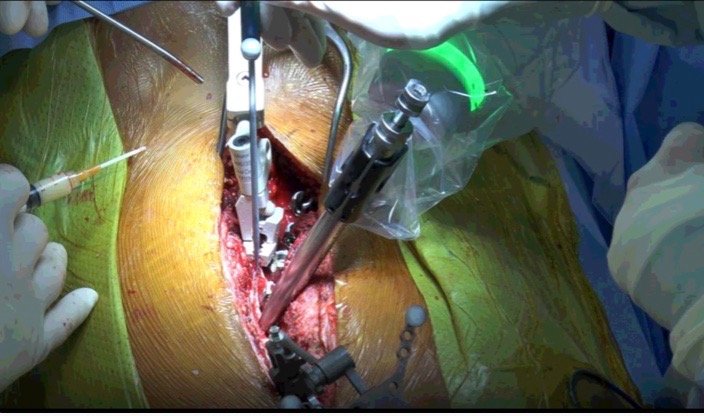 |
| Robotic aiming arm with cannula inserted, confirming starting position with the use of navigation instrumentation. |
Potential benefits
Once the system is fully implemented and surgical teams trained, the robotic guidance system has potential benefits for both patients and providers. The system could increase the accuracy of screw placement and lead to a decrease in revision surgeries. Spinal fusion surgeries could be completed in less time, reducing patients’ time under anesthesia and exposure to fluoroscopy. By reducing the handling and reprocessing of screws and trays in the operating room (OR), robotic guidance could also reduce the risk of infection. It will take further study, however, to determine if these potential improvements will play out.
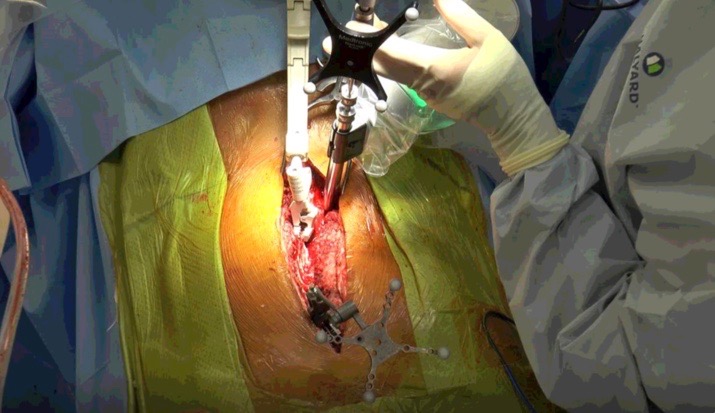 |
| Advancing the navigated drill through the robotic aiming arm with cannula |
Future innovations
The Boston Children’s Spine Division chose to embark on this project because we believe robotic guidance will be a driving force in the rapidly expanding field of surgical technologies. Demands for patient safety, quality of care, cost-effectiveness, as well as payor regulations will be primary drivers in the continued evolution of robotic technologies and their widespread adoption in the OR.
To help ensure robotic guidance technology delivers its potential benefits, the Spine Division is forming a study group with the four other pediatric centers that are also early adopters of the Mazor X Stealth Edition system. Together, we will pool and analyze surgical data to determine the impact of robotic navigation on factors such as surgical efficiency, patient safety, time in the OR, and fluoroscopy exposure. In the future, we may also serve as a center for surgeon visitation, where other providers can see the system in use.
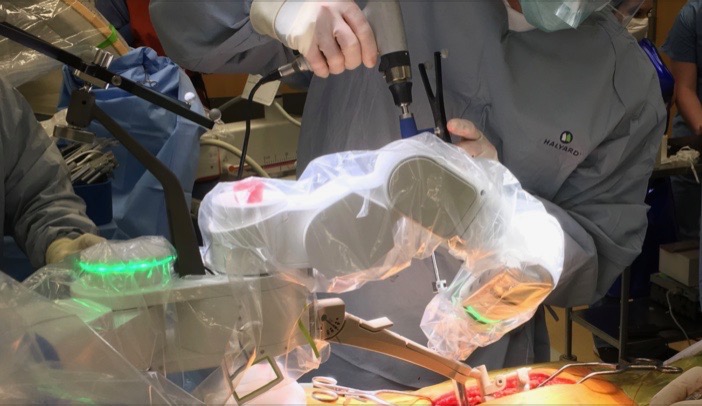 |
| Additional view of the process of advancing the navigated drill through the robotic aiming arm |
Key takeaways
Any spine center considering a robotic guidance system should keep the following points in mind:
- Robotics will have a profound and lasting impact on surgical technologies of the future.
- Any surgeon using the robotic guidance system should have extensive experience and knowledge of spinal fusion surgery to assure patient safety.
- The initial learning curve is steep and requires an up-front commitment of time as surgical teams become familiar with the system.
- Surgical teams should plan to debrief after each case to review the procedure and possible efficiency improvements for the future.
- Robotic navigation has the potential to improve accuracy and efficiency and reduce costs, however, at this early stage, these benefits have not been tested.
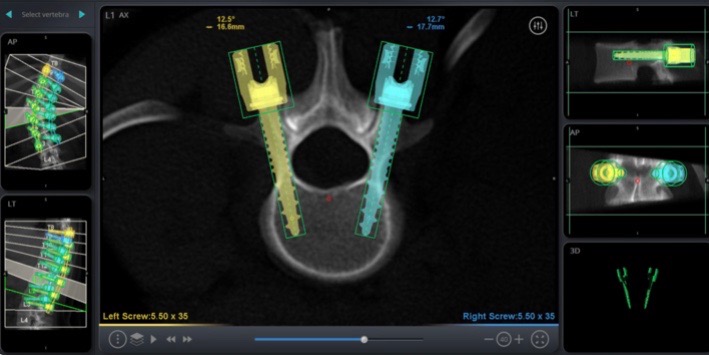 |
| Screen shot of intraoperative planning software, setting the starting point, trajectory, and size of pedicle screws |
Robotic guidance: Technology components
The Mazor X Stealth robotic guidance system is an expansion of the O-arm intraoperative CT scanning technology and surgical navigation that has been in use in the Spine Division since 2015. The robotic guidance system introduces the following components to spinal surgeries:
Preoperative planning software — Using anatomical images, the software helps surgical teams determine appropriate screw size for the patient before the surgery, eliminating the need for back-up implant trays in the surgical suite. Surgical teams can also use the software to plan ahead for surgeries on difficult anatomies.
Robotic arm — After registering a patient’s anatomy and confirming anatomical landmarks, the robotic arm guides the trajectory of pedicle screw placement.
Stealth navigation — Provides real-time confirmation of the patient’s anatomy and screw trajectory, enabling the surgeon to verify the exact placement of each implant.
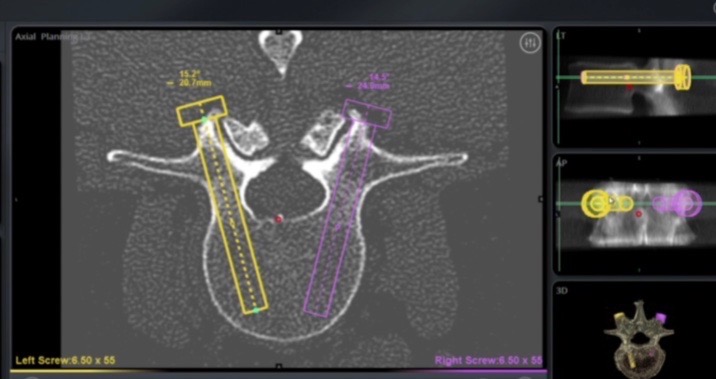 |
| Additional pre- or intra-operative planning view option allowing visualization of the computed topography (CT) anatomy and planned pedicle screw trajectory |
 |
| X-rays of spine pre- and post-surgery with Mazor X |
Publications
Gonzalez D, Ghessese S, Cook D, Hedequist D. Initial intraoperative experience with robotic-assisted pedicle screw placement with stealth navigation in pediatric spine deformity: an evaluation of the first 40 cases. J Robot Surg. 2020 Oct 22. doi: 10.1007/s11701-020-01159-3. Online ahead of print.
Hedequist DJ, Erikson MA, Larson AN. Navigation and Robotics in Pediatric Spine Surgery. JPOSNA. May 2020; Vol 2 No 1.
